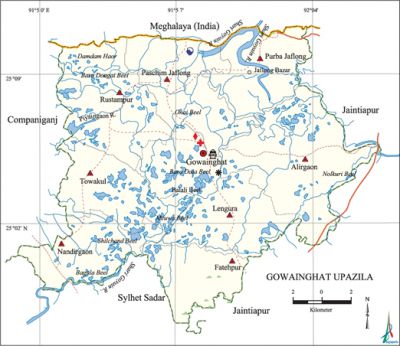Gowainghat Upazila
Gowainghat Upazila (sylhet district) area 486.10 sq km, located in between 24°55' and 25°11' north latitudes and in between 91°45' and 92°07' east longitudes. It is bounded by Meghalaya state of India on the north, sylhet sadar and jaintiapur upazilas on the south, Jaintiapur upazila on the east, companiganj upazila on the west. Jafflong is an important tourist spot. Tamabil land port is used for importing coal and other goods from India.
Population Total 207170; male 107314, female 99856; Muslim 190518, Hindu 15809, Buddhist 711, Christian 22 and others 110. Indigenous community such as khasia belongs to this upazila.
Water bodies Main rivers: shari-goyain and piyain; Damdam Haor and Bara Daia Beel, Shilchand Beel, Bara Dongai Beel, Onai Beel, Balali Beel and Nolkuri Beel are notable.
Administration Gawainghat Thana was formed in 1908 and it was turned into an upazila in 1983.
| Upazila | ||||||||
| Municipality | Union | Mouza | Village | Population | Density (per sq km) | Literacy rate (%) | ||
| Urban | Rural | Urban | Rural | |||||
|
- |
8 |
260 |
267 |
4568 |
202602 |
426 |
33.24 |
22.56 |
| Upazila Town | ||||||||
|
Area (sq km) |
Mouza |
Population |
Density (per sq km) |
Literacy rate | ||||
|
3.51 |
2 |
4568 |
1301 |
33.24 | ||||
| Union | ||||
| Name of union and GO code | Area (acre) | Population | Literacy rate (%) | |
| Male | Female | |||
|
Alirgaon 10 |
21598 |
16846 |
16230 |
17.48 |
|
Towakul 84 |
12292 |
9588 |
8818 |
19.45 |
|
Nandirgaon 63 |
11061 |
9170 |
8341 |
32.80 |
|
Paschim Jaflong 42 |
14765 |
15261 |
14088 |
28.81 |
|
Purba Jaflong 31 |
11862 |
18839 |
17498 |
25.28 |
|
Fatehpur 21 |
9679 |
7945 |
7589 |
23.01 |
|
Rustampur 73 |
17106 |
15136 |
13954 |
22.12 |
|
Lengura 52 |
20072 |
14529 |
13338 |
15.93 |
Source Bangladesh Population Census 2001,Bangladesh Bureau of Statistics.

History of the War of Liberation On 28 November 1971, the Pak army launched a surprise night attack at village Ujuhat of Alirgaon Union and killed 25 freedom fighters.
Marks of the War of Liberation Mass grave 7 (Tamabil zero point, Ujuhat, Atgram, Gowainghat Health Complex area and Birkuli); memorial monument 1 (Upazila sadar).
Religious institutions Mosque 500, temple 80, church 10, tomb 10.
Literacy rate and educational institutions Average literacy 22.81%; male 27.02%, female 18.29%. Noted educational institutions: Gowainghat Degree College, Gowainghat High School (1952), Alirgaon High School.
Cultural organisations Library 1, shilpakala academy 1,' auditorium 1, community centre 1, playground 10.
Main sources of income Agriculture 59.40%, non-agricultural labourer 14.44%, industry 0.55%, commerce 9.54%, transport and communication 0.67%, service 2.36%, construction 0.49%, religious service 0.42%, rent and remittance 1.24% and others 10.89%.
Ownership of agricultural land Landowner 56.30%, landless 43.70%; agricultural landowner: urban 51.89% and rural 56.40%.
Main crops Paddy, tea, betel leaf, mustard, vegetables.
Extinct or nearly extinct crops Linseed, sesame, taykar, satkara.
Main fruits Jackfruit, mango, papaya, banana, betel nut, orange, pineapple, shaddock, palm.
Fisheries, dairies and poultries Fishery 10, dairy 2, poultry 20.
Communication facilities Roads: pucca 90 km, semi pucca 20 km, mud road 150 km; waterways 40 nautical miles. Culverts 144, bridges 84.
Extinct or nearly extinct traditional transport Palanquin, bullock cart, horse carriage.
Manufactories Stone crushing plant, rice mill, brick field 3, tea processing factory, saw mill.
Cottage industries Bamboo work, cane work.
Hats, bazars and fairs Hats and bazars are 19, most noted of which are Gowainghat, Radhanagar, Jaflong, Ballaghat, Hadarpar and Salutikar hats.
Main exports Tea, betel leaf, orange, boulder, sand and fish.
Access to electricity All the unions of the upazila are under rural electrification net-work. However 7.11% of the dwellings have access to electricity.'
Sources of drinking water Tube-well 44.76%, tap 1.14%, pond 37.77% and others 16.33%. The presence of arsenic at an intolerable level has been detected in 13.7% shallow tube-wells of the upazila.
Sanitation 18.52% (rural 18.11% and urban 35.39%) of dwelling households of the upazila use sanitary latrines and 56.59% (rural 57.25% and urban 29.35%) of dwelling household use non-sanitary latrines; 24.89% of households do not have latrine facilities.
Health centres Upazila health centre 1, rural health centre 3, family welfare centre 5, charity hospital 1.
NGO activities asa, brac, tmms, FIVDB. [Abdul Hai Al-Hadi]
References Bangladesh Population Census 2001, Bangladesh Bureau of Statistics; Field report of Gowainghat Upazila 2010.
